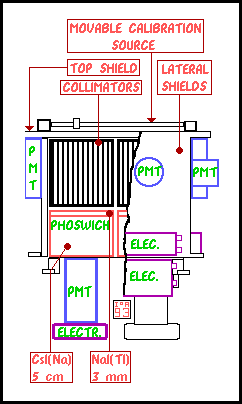SAX: Phoswich Detector System (PDS)




Next: Wide Field Cameras (WFC)
Previous: High Pressure GSPC
Up: SAX Home Page
Contents: Table of Contents
This is only a general description of the instrument. Please, refer to the
Instrument Home Pages for updated information.
- The SAX PDS has an energy range of 15-300 keV and is dedicated to
celestial X-ray source studies in the upper range of the energy band of the
narrow field of view instruments.
- To achieve high sensitivity in the discrimination of celestial X-ray
sources from the background, the PDS employs:

- four inorganic scintillation crystal units - called phoswiches;
- two hexagonal cell collimator arrays each with a 1.5 degrees field of
view employed as in the HP-GSPC;
- four lateral active shields and one top active shield.
- Each phoswich contains a thin front primary crystal of Thallium doped
Sodium Iodide - NaI(Tl) - and thick rear crystal of Sodium doped Cesium
Iodide - CsI(Na). These crystals have substantially different scintillation
decay times. X-rays arriving in the instrument from a celestial source under
observation will mainly interact, producing scintillation light, in the front
primary crystal and can be discriminated against the background arriving from
all directions, seen by the rear crystal, by analysis of the shape of the
pulse from the photomultiplier tube attached to the crystal unit. The four
active lateral shields again made of CsI (Na), and the top active shield of
plastic scintillator which detects charged particles, are used to further
discriminate against background, increasing the instrument sensitivity.
- A phoswich signal is correlated to an X-ray photon from cosmic sources
when: a photon is coming from the top within the field of view, is detected
only by one phoswich unit, and with no detection by either the lateral
shields, the top shield or the other phoswiches.
- In addition the lateral shields are employed to detect gamma-ray bursts
in the 60-600 keV energy range. Apart from the intensity and temporal evolution
of these bursts, their rough direction of origin can be determined.
This file was last modified on Wednesday, 02-Sep-1998 17:28:56 CEST
by Mauro Orlandini




Next: Wide Field Cameras (WFC)
Previous: High Pressure GSPC
Up: SAX Home Page
Contents: Table of Contents

